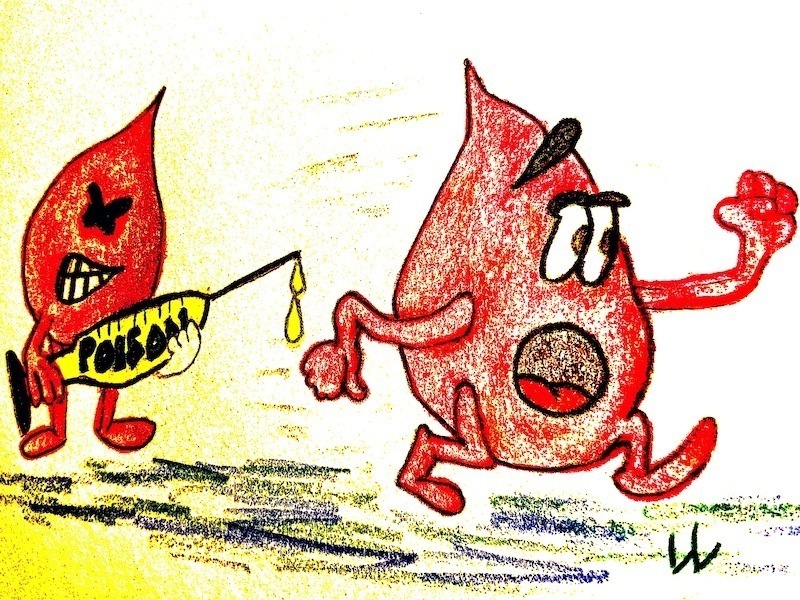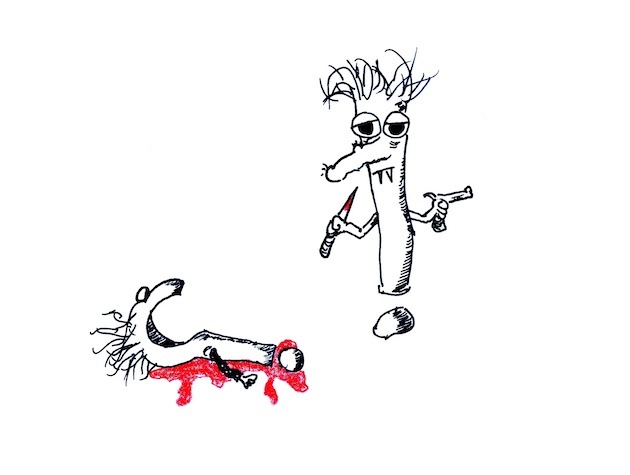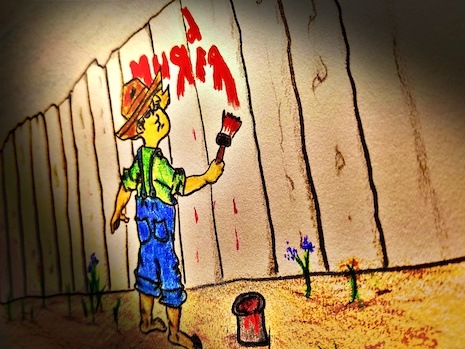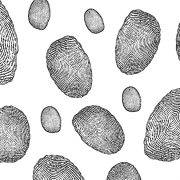Terms Not So Endearing: The Language of Cops, Attorneys, and Crooks
A&B: Assault and battery
AKA: Also known as.
Aikido: Police defensive-tactics techniques developed from this particular style of Japanese martial arts.
Abscond: To secretly leave the jurisdiction of a court or to conceal one’s self from law-enforcement officials.
Accessory: One who aids or assists in the commission of a crime.
Aid and Abet: To voluntarily assist another person in the commission of a crime.
Alternate Light Source: Equipment used to enhance potential items of evidence, either visible or invisible light at varying wavelengths.
Amicus Curiae (Latin): A friend of the court; someone who is not a party to court proceedings that supplies information to the court that otherwise may not be readily available.
Arrest: To deprive someone of his liberty, or to seize a person suspected of a crime.

B&E: Break and enter
Bench Warrant: An arrest warrant issued by the court.
Bindle Paper: Clean paper folded to contain trace evidence such as hairs or fibers.
Biohazard Bag: A red, plastic bag used to contain materials that have been exposed to blood and other body fluids and parts. The container will be clearly marked as Biohazard Material in bold lettering.
Biological Weapon: Agents used to threaten or destroy human life, e.g. anthrax, smallpox, E. coli, etc.
Bloodborne Pathogen: Infectious, disease-causing microorganisms found in biological fluids.

Blow: Cocaine.
BOLO: Police acronym for Be On The Lookout.
Bread Slicing: The method of slicing of body organs by a medical examiner. The organs are sliced into sections resembling a loaf of bread.
Breaking and Entering: Any act of physical force in which obstruction to entrance of a building is removed. Simply pushing a door open or raising a window can be considered “breaking.” Breaking and entering are two of the elements of burglary.
Bullet: A one-year prison sentence.
Burglary: Breaking into any dwelling in the nighttime with the intent to commit a felony.
CI: Confidential informant
Capital Murder: The willful, deliberate, and premeditated killing of any person in conjunction with the following:
- Abduction, when the abduction is committed with the intent to extort money or a pecuniary benefit.
- The willful, deliberate, and premeditated killing of any person by another for hire.
- The killing of any person by a prisoner of a state or local corrections facility or while in the custody of an employee thereof.
- The killing of another during the commission of a robbery or attempted robbery, while armed with a deadly weapon.
- The killing of any person in the commission of and subsequent to rape, or attempted rape, or forcible or attempted forcible sodomy.
- The killing of any law-enforcement officer when the purpose interferes with the performance of his duties.
- The killing of more than one person as part of the same act or transaction.
- The killing of any child under the age of twelve during the commission of abduction.
- The killing of any person during the commission of or attempting to commit a violation of Schedule I or Schedule II Drug Laws.
(Capital Murder offense laws can vary from state to state. Please check the laws governing your state).
(See murder below)
Carnal Knowledge: Sexual intercourse.
Case File: Collection of documents pertaining to a particular investigation.
Case Identifiers: Alphabetic or numeric assignment of characters used to identify a particular case.
Chain of Custody: A chronological history of the evidence. This is a list of all persons handling, holding, or having possession of a piece of evidence. The document will contain all pertinent information such as names, dates, victims, suspects, etc.
Chemical Enhancement: Use of chemicals to aid detection and documentation of evidence (e.g. semen, blood, fingerprints, narcotics) that may be difficult to see with the human eye alone.
Conspiracy: Two or more persons working together to commit an illegal act.
Contra Pacem (Latin): Against the peace.
Corpus Delicti (Latin): Body of the crime; the proof that a crime has been committed.
Crimen Falsi (Latin): Literally a crime of deceit or fraud.
Criminal Mischief: A crime committed against property.
CSU: Crime Scene Unit

Drop A Dime: To snitch on someone.
Drowning: Water and mucus in the airway of a drowning victim create a foamy mixture as the victim struggles to breathe. The foam is discovered during an autopsy and confirms that a drowning has occurred.
Dying Declaration: Statement given by a person who believes he is about to die, concerning the cause of the circumstances surrounding a specific crime or chain of events, usually about his own impending death. A strong piece of evidence highly regarded by courts as truth. A dying declaration is important evidence, but courts no longer accept this type of statement alone as sufficient evidence for a conviction. There must normally be other supporting evidence.
EDTA: Anti-coagulant in purple-topped blood vials.
En Banc (French) By the full court. A matter heard by the entire appellate court.
ETA: Estimated time of arrival.
Exclusionary Rule: Protects against the use of evidence in court that was seized during an illegal search by police.
Exigent Circumstances: Emergency conditions
Felony: A crime punishable by either death or confinement in a state correctional facility.
First-Degree Murder: Murder by poison, lying in wait, imprisonment, starving, or by any willful, deliberate, and pre-meditated killing, or in the commission of, or attempt to commit arson, rape, forcible sodomy, inanimate-object sexual penetration, robbery, burglary, or abduction. (This definition varies in different states.) All other murder, other than capital murder, is defined as second-degree murder.
Fishing: The use of a long piece of string or elastic from the waistband of underwear by a prisoner to retrieve an object from an adjoining cell.
GSW: Gunshot wound.
Habeas Corpus (Latin): You have the body. Tests the legality of imprisonment or confinement.
Homicide: The killing of any human being by another.

Hot Pursuit: The action of pursuing or chasing a suspect in a crime. Hot pursuit allows officers to cross jurisdictional boundaries in order to apprehend a suspect, however the suspect must remain in sight for the chase to be justified as a hot pursuit.

Impression Evidence: Objects or items that have retained identifying characteristics of another object that has been pressed against them (footprints, tool marks, etc.).
Ink: Tattoos.
Latent Print: A print that is not visible to the naked eye, made by contact with a surface by hands, or feet transferring human material to that surface.
Jailhouse Lawyer: An inmate not licensed to practice law who assist other inmates with legal matters, such as appeals.
Lying in Wait: Hiding for the purpose of committing a crime.
Lynching: Any violence by a mob upon the body of any person, resulting in the death of that person.
LZ: Landing zone (typically used when referring to helicopters)

Misdemeanor: All crimes not deemed as felonies and punishable by fines and/or incarceration in facilities other than state or federal institutions (county jails, halfway houses, home confinement, etc.).
Modus Operandi (Latin): The manner of operation. A specific means or method of accomplishing an act.
Murder: An unlawful homicide.

MVA: Motor vehicle accident.
NCIC: National Crime Information Center.
Nolo Contendere (Latin): I do not wish to contend, fight, or maintain (a defense). A plea of not wishing to present a defense in a criminal matter.
Parole: Allows a prisoner to serve the remainder of a sentence outside prison walls. He will serve the sentence under the supervision of a parole officer. If the conditions of parole are not met, the offender will be returned to prison to serve any remaining sentence. Parole is not a part of a sentence.
PD: Police department.

Personal Protective Equipment: Items such as latex gloves, masks, and eye protection used as a protective barrier against biohazardous materials, disease, and to avoid human contamination of a crime scene.
Petechiae: Tiny purple or red spots on the eyes, neck, face, and/or lungs, indicating death by asphyxiation. (Bleeding does not have to be present. See Petechial Hemorrhage below.)
Petechial Hemorrhage: Tiny purple or red spots on the eyes or skin caused by small areas of bleeding. (See Petechiae above.)
PO: Probation Officer.
POV: Privately owned vehicle.
Presumptive Test: A test used to screen for the presence of a specific substance, such as a narcotic. The results of a presumptive test cannot be used for evidential confirmation, or as a certification in a court of law. A presumptive test adds to investigators’ reasonable suspicions and is considered to be probable cause for the issuance of a search warrant or a warrant of arrest. The final, legal, testing must be completed in a certified laboratory by certified personnel.
Pro Bono Publico (Latin): For the public good or welfare. Without a fee. An attorney working for free is said to be working Pro Bono.
Projectile Trajectory Analysis: The method used for determining the path of travel of a high-speed object such as a bullet or arrow.
Probation: A sentence in lieu of imprisonment. A probation officer supervises a subject on probation.
Purple Top Vial: A vial used for blood samples, which contains EDTA, an anti-coagulant.
Res Judicata (Latin): The thing has been decided.
Seg: Prison segregation unit.
Shakedown: A search of a prison cell.

Shiv: A homemade knife.
SHU: Special Housing Unit. A special lockup facility within a prison that’s usually reserved for housing violent offenders.
Slimers: A prison inmate who throws urine or fecal matter at people passing by the prisoner’s cell. They sometimes pack the offensive substance into toothpaste tubes and squirt it at their intended targets.
Stop and Frisk: Allows a police officer to search a person for weapons without a warrant. It is a pat-down search of the person’s outer clothing only.
Trace Evidence: Evidence in small quantities, such as hair, fibers, gunshot residue, and particles of glass.
Transient Evidence: Evidence that can be easily lost or destroyed by conditions at a scene if not protected or preserved (evidence exposed to the elements).
Venue: The place where a trial is held.
Voir Dire (French): To speak the truth. An examination or questioning of potential jurors conducted by the court or attorneys to determine truthfulness and ability to serve for jury duty.
Warrant: A written order directing someone to do something.
Yard: Outdoor recreation area of a prison.







Thanks, Lee. I’ll have to keep this post handy for reference!
That took a lot of work! Thanks for the dictionary.
I’m glad you found the material useful. Thank for stopping by.
Thanks Lee, for helping me keep my dialog real.